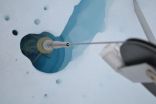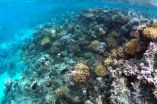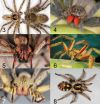(Press-News.org) AUSTIN, Texas—A team led by scientists at the University of Texas at Austin's Institute for Geophysics has for the first time directly observed multiple parts of Greenland's subglacial plumbing system and how that system evolves each summer to slow down the ice sheet's movement toward the sea.
These new observations could be important in accurately modeling Greenland's future response to climate change.
"Everyone wants to know what's happening under Greenland as it experiences more and more melt," said study coauthor Ginny Catania, a research scientist at the institute and an associate professor in the university's Jackson School of Geosciences. "This subglacial plumbing may or may not be critical for sea level rise in the next 100 years, but we don't really know until we fully understand it."
Each summer, the surface of the Greenland Ice Sheet melts as temperatures warm, sending meltwater into channels that drain to the bottom of the ice sheet, lubricating the underside and speeding up the ice sheet's flow toward the sea. While the basic outline of this process is understood, scientists have been puzzled about how the meltwater interacts with the bed of the ice sheet. These new observations clarify scientific understanding of how this plumbing system evolves each summer and how it may change in the future as the climate continues to warm.
The findings, published Oct. 2 in Nature, describe an efficient drainage system in which meltwater from the surface drains into moulins, naturally formed pipes that drain water through more than half a mile of ice to passageways between the bedrock and overlying ice. The higher the water level—or pressure—in the moulin, the faster the ice sheet slides, and in recent decades the amount of summer surface melting has increased.
The scientists found that while the extra meltwater does cause a rapid daily speedup of the ice sheet, the ice gradually becomes less and less sensitive to melting over the course of the summer season. This behavior suggests that a component of the subglacial plumbing system is adapting to the increased meltwater, said lead author Lauren Andrews, a Ph.D. candidate at The University of Texas at Austin.
In 2011, Andrews and her colleagues drilled 13 boreholes through ice up to 2,300 feet thick in the Paakitsoq region of western Greenland. During the summers of 2011 and 2012, they measured water pressure in the boreholes and three nearby moulins to gauge the strength of meltwater flow in the subglacial plumbing network. GPS units tracked ice velocity on the surface.
The scientists discovered that there are two key parts to the subglacial plumbing system that change on different timescales. In the first, water draining through moulins forms a network of subglacial channels that regulates daily changes in ice flow. In the second, the borehole records indicate that there are also large regions of the bed that are isolated from the channel network.
"At the beginning of the season, there's little exchange of water between these two systems, but they gradually connect over the course of the melt season, relieving pressure in the isolated regions of the bed," said Andrews. Such a connection would lower the water pressure and lead to a seasonal decrease in the ice sheet's sensitivity to melting, she added. Thus, the ice sheet may not move as much as the surface melting might indicate.
New models of Greenland's subglacial drainage system that account for these previously unknown borehole regions are now needed, Catania said.
"If we don't get this hydrology right, and if we don't couple it to models of ice flow, then we can't model the system properly and won't be able to project into the future very well," Catania said.
INFORMATION:
Scientists from Los Alamos National Laboratory, Michigan Technological University, University of Zurich, Swiss Federal Institute of Technology, NASA Goddard Space Flight Center and Dartmouth College contributed to the research.
The research was funded by the National Science Foundation, Swiss National Science Foundation and the National Geographic Society.
Evolving plumbing system beneath Greenland slows ice sheet as summer progresses
2014-10-01
ELSE PRESS RELEASES FROM THIS DATE:
Winter is coming ... to Titan's south pole
2014-10-01
Titan is unique in our solar system because of its dense nitrogen-methane atmosphere, which is very similar to Earth's in some ways, but very different in others. For example, air temperatures are around 200 degrees colder and, in contrast to the warm salt water seas of Earth, frigid hydrocarbon lakes populate Titan's surface.
Titan has seasons just like Earth, only each season lasts over seven years instead of three months due to its ponderous orbit around the Sun. After equinox in 2009, Titan's south pole entered the perpetual darkness of polar winter. Soon after, ...
Solving the mystery of the 'man in the moon'
2014-10-01
New data obtained by NASA's GRAIL mission reveals that the Procellarum region on the near side of the moon — a giant basin often referred to as the "man in the moon" — likely arose not from a massive asteroid strike, but from a large plume of magma deep within the moon's interior.
The Procellarum region is a roughly circular, volcanic terrain some 1,800 miles in diameter — nearly as wide as the United States. One hypothesis suggested that it was formed by a massive impact, in which case it would have been the largest impact basin on the moon. Subsequent asteroid collisions ...
Origin of moon's 'ocean of storms' revealed
2014-10-01
PROVIDENCE, R.I. [Brown University] — Oceanus Procellarum, a vast dark patch visible on the western edge of the Moon's near side, has long been a source of mystery for planetary scientists. Some have suggested that the "ocean of storms" is part of a giant basin formed by an asteroid impact early in the Moon's history. But new research published today in Nature deals a pretty big blow to the impact theory.
The new study, based on data from NASA's GRAIL mission, found a series of linear gravitational anomalies forming a giant rectangle, nearly 1,600 miles across, running ...
Researchers develop novel gene/cell therapy approach for lung disease
2014-10-01
CINCINNATI – Researchers developed a new type of cell transplantation to treat mice mimicking a rare lung disease that one day could be used to treat this and other human lung diseases caused by dysfunctional immune cells.
Scientists at Cincinnati Children's Hospital Medical Center report their findings in a study posted online Oct. 1 by Nature. In the study, the authors used macrophages, a type of immune cell that helps collect and remove used molecules and cell debris from the body.
They transplanted either normal or gene-corrected macrophages into the respiratory ...
New frontier in error-correcting codes
2014-10-01
CAMBRIDGE, Mass--Error-correcting codes are one of the glories of the information age: They're what guarantee the flawless transmission of digital information over the airwaves or through copper wire, even in the presence of the corrupting influences that engineers call "noise."
But classical error-correcting codes work best with large chunks of data: The bigger the chunk, the higher the rate at which it can be transmitted error-free. In the Internet age, however, distributed computing is becoming more and more common, with devices repeatedly exchanging small chunks of ...
Coral reef winners and losers
2014-10-01
Contrary to the popular research-based assumption that the world's coral reefs are doomed, a new longitudinal study from UC Santa Barbara's National Center for Ecological Analysis and Synthesis (NCEAS) paints a brighter picture of how corals may fare in the future.
An NCEAS working group reports that there will be winners and losers among coral species facing increasing natural and human-caused stressors. However, its experts demonstrate that a subset of the present coral fauna will likely populate the world's oceans as water temperatures continue to rise. The findings ...
Proving 'group selection'
2014-10-01
PITTSBURGH—The notion of "group selection"—that members of social species exhibit individual behavioral traits that render a population more or less fit for survival—has been bandied about in evolutionary biology since Darwin. The essence of the argument against the theory is that it's a "fuzzy" concept without the precision of gene-based selection.
Jonathan Pruitt, assistant professor of behavioral ecology in the University of Pittsburgh's Department of Biological Sciences within the Kenneth P. Dietrich School of Arts and Sciences, has published a paper today in the ...
New study provides key to identifying spiders in international cargo
2014-10-01
Spiders found in international cargo brought into North America are sometimes submitted to arachnologists for identification. Often, these spiders are presumed to be of medical importance because of their size or similarity to spiders that are known to be venomous.
In 2006, after witnessing multiple episodes where harmless spiders were mistaken for toxic ones, Dr. Richard Vetter, an arachnologist at the University of California, asked other arachnologists to provide data on specimens they found in international cargo that had been submitted to them for identification. ...
Scientists aim to give botox a safer facelift
2014-10-01
New insights into botulinum neurotoxins and their interactions with cells are moving scientists ever closer to safer forms of Botox and a better understanding of the dangerous disease known as botulism. By comparing all known structures of botulinum neurotoxins, researchers writing in the Cell Press journal Trends in Biochemical Sciences on October 1st suggest new ways to improve the safety and efficacy of Botox injections.
"If we know from high-resolution structures how botulinum neurotoxins interact with their receptors, we can design inhibitors or specific antibodies ...
Journal supplement examines innovative strategies for healthy aging
2014-10-01
WASHINGTON— The Society for Public Health Education (SOPHE) proudly announces the publication of a Health Education & Behavior (HE&B) supplement devoted to the latest research and practice to promote healthy aging. The October 2014 supplement, "Fostering Engagement and Independence: Opportunities and Challenges for an Aging Society," contains a dozen peer-reviewed articles on innovative behavioral and psycho-social approaches to improve the health of the nation's fastest growing cohort - older adults.
Together the articles describe promising advances in research directed ...





